At the highland markets of Ha Giang, you’ll easily spot round, flat or elongated cakes in vibrant colors, with rough surfaces and rock-hard textures. When properly prepared, these cakes become chewy, fragrant, and incredibly appetizing. Due to their distinctive hardness, they’re called “stone cakes” – an unmissable specialty when visiting Vietnam’s rocky plateau region.
In this article, Phieu Travel will help you discover what Ha Giang stone cake is, share 5 delicious preparation methods, provide homemade recipes, preservation tips, and suggestions on where to buy this unique treat. Let’s explore!
1. What is Ha Giang stone cake?
Stone cake, locally called “lua khoai,” is a traditional delicacy of the Dao Ao Dai and Nung ethnic communities in Ha Giang. Made from mountain sticky rice and colored with natural ingredients like butterfly pea flowers and gac fruit, this cake’s uniqueness lies in its preparation and preservation methods, which make it hard when raw but chewy after cooking.
To better understand Ha Giang stone cake, let’s explore its origin, traditional preparation process, and the unique preservation method of this specialty.
1.1 Origin of the Name “Stone Cake”
The name “stone cake” comes from the hardness of the cake in its raw form. With its round, flat or elongated shape, rough surface, and solid texture, the cake reminds people of dry pebbles by a stream. This is why locals call this food “stone cake.”
For generations, this cake has been an integral part of daily meals for the Dao and Nung communities, playing an important role in festivals, weddings, and harvest celebrations. With Ha Giang’s tourism boom, stone cake has gained wider recognition and become a popular souvenir for visitors.
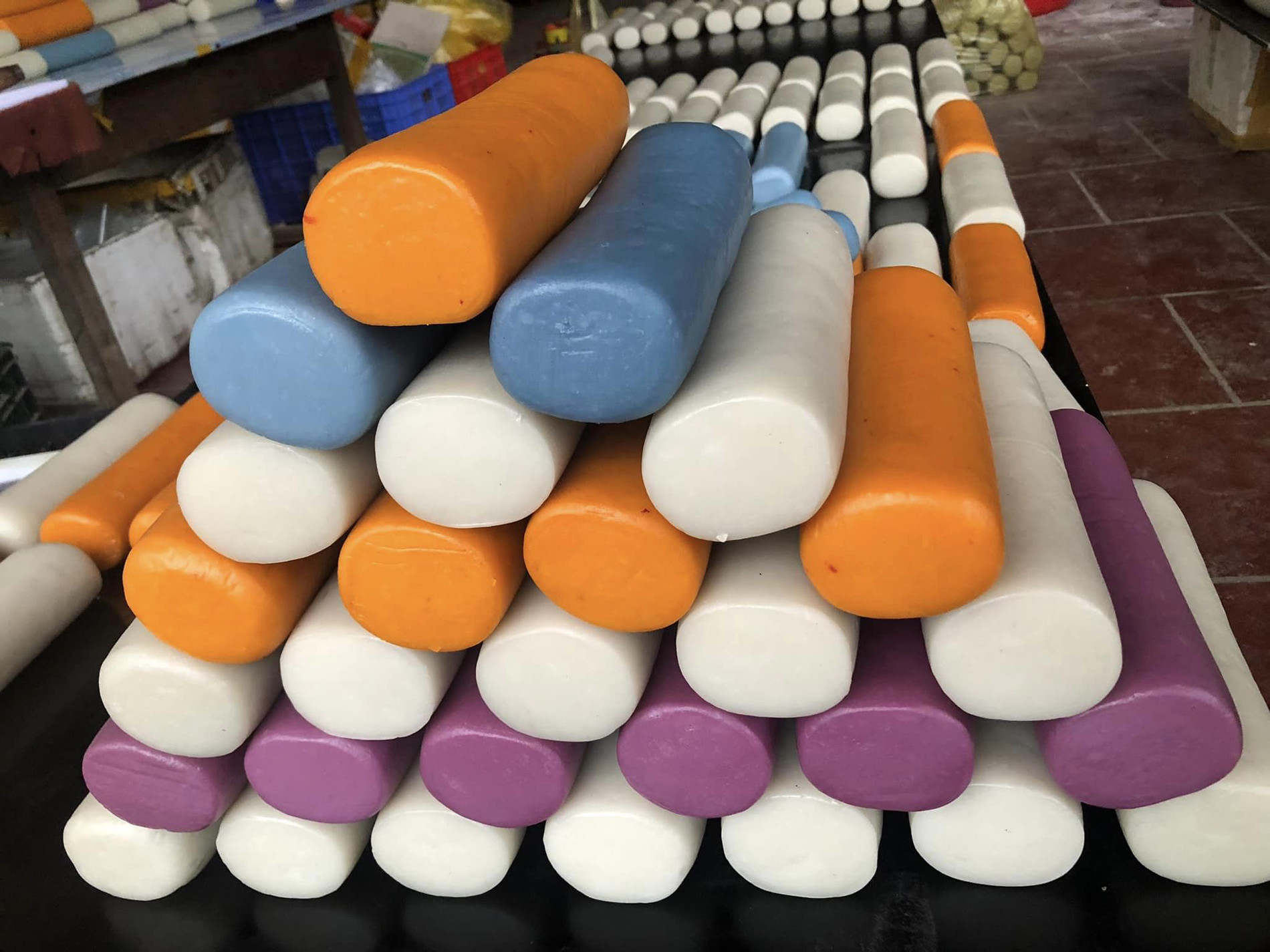
1.2 How is Stone Cake Made?
The main ingredient of Ha Giang stone cake is mountain sticky rice or a mixture of sticky and regular rice, carefully selected for plumpness and aroma. After harvesting, the rice is soaked for 4-6 hours, then dried and ground into fine flour. For vibrant colors, natural ingredients like purple magenta leaves, butterfly pea flowers, turmeric, gac fruit, or pandan leaves are used to create natural dyes that are mixed into the flour.
The flour is steamed until cooked, then quickly pounded while still hot until it reaches the desired elasticity. While the dough is still warm, it’s shaped into cylinders or elongated forms. The shaping must be done decisively and continuously – if hands move too slowly, the cooling dough won’t stick together properly. After shaping, the cakes are left to cool completely and then wrapped in rice straw for three days to dry gradually before moving to the preservation stage.
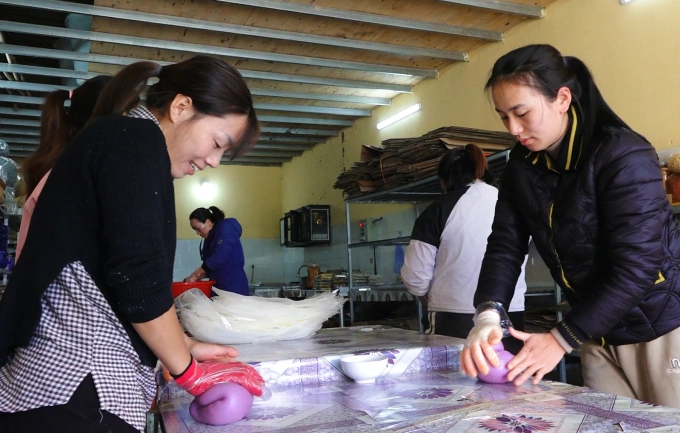
1.3 The Unique Preservation Method of Stone Cake
After the straw-wrapping period, a natural mold appears on the cake’s surface. At this stage, locals place the cakes under rocky streams near their homes. The cold stream water prevents spoilage and mold growth while maintaining the cake’s elasticity for later preparation. Whenever needed, they simply retrieve the cakes from the stream and steam them again.
Today, for convenient transportation and extended shelf life, many cake producers have switched to vacuum-sealing and careful packaging immediately after production. After purchase, stone cakes should be stored in the refrigerator to maintain moisture, flavor, and prevent mold growth.
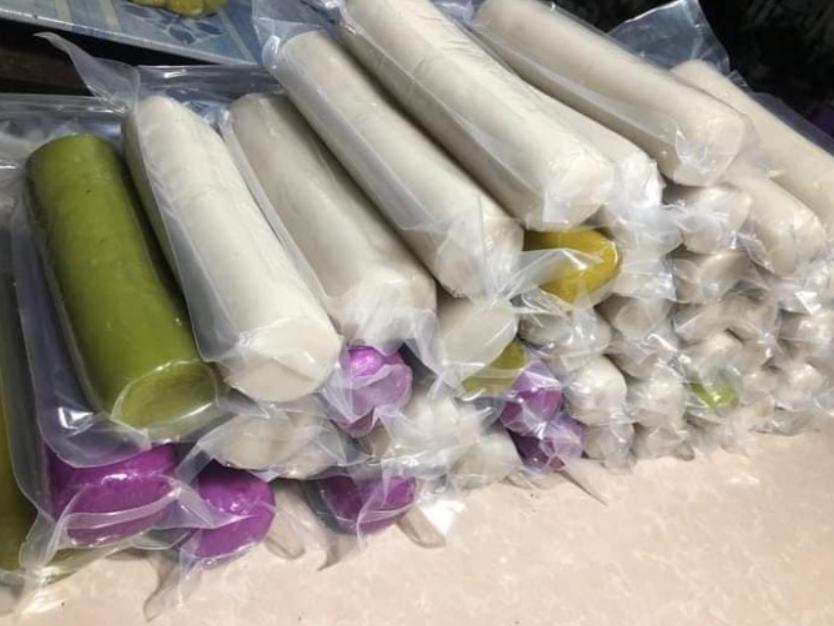
2. 5 Delicious Ways to Prepare Ha Giang Stone Cake
In its original form, stone cake has a chewy, fragrant texture with a subtle sweetness. If simply steamed or grilled and eaten plain, it might taste bland and become tiresome. Here are 5 preparation methods to enhance its flavor and create exciting new experiences when enjoying stone cake.
2.1 Stone Cake with Condensed Milk
Cut the stone cake into small pieces, then steam or grill until the outside is crispy golden while the inside remains chewy. When eating, dip directly into condensed milk. The rich creaminess of the milk blends harmoniously with the chewy, fragrant cake, creating a balanced, easy-to-enjoy flavor.
2.2 Fried Stone Cake
After cutting into pieces, deep-fry the stone cake until its surface turns golden and crispy. The crunchy exterior combined with the chewy, fragrant interior creates an unusual and addictive texture. You can dip it in chili sauce for a mild spiciness or enjoy it plain to fully appreciate the rich, nutty flavor of the sticky rice.

2.3 Stone Cake in Sweet Ginger Syrup
“Thang den” is a traditional highland dessert, similar to the sweet glutinous rice balls from the lowlands. When combined with stone cake, this dish becomes uniquely exotic with distinct mountain flavors. The cake is sliced into strips or small pieces, boiled until soft, then served with ginger-infused syrup. Sprinkle with roasted peanuts to add crunchiness and nutty flavor. The chewy texture combined with sweet and mildly spicy flavors creates an unforgettable taste.
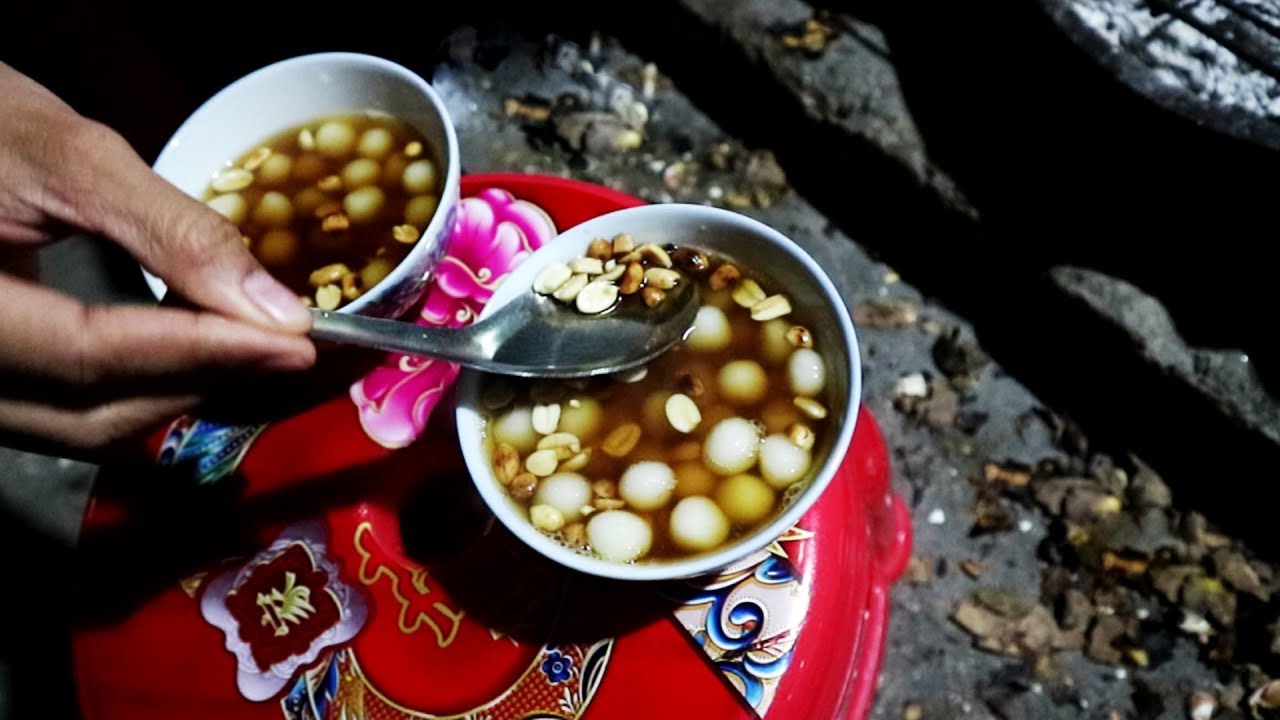
2.4 Stone Cake Noodle Soup
Instead of using regular noodles, you can cut stone cake into strips and use them as the main ingredient in noodle soup. When cooked, stone cake maintains its chewiness and fragrant, nutty flavor thanks to the mountain sticky rice. The cake absorbs the broth flavors and, when eaten with meat, sausage, or shrimp, offers a fresh experience of a familiar dish.
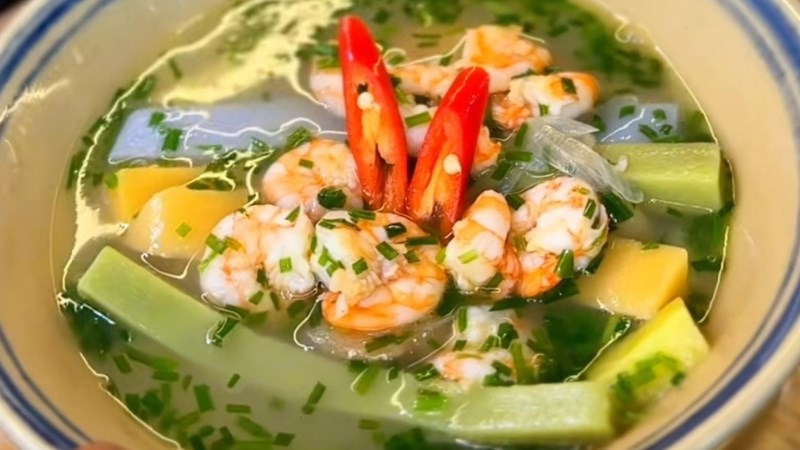
2.5 Stone Cake Tteokbokki
With its chewy texture and distinctive mild nutty flavor, stone cake can perfectly substitute for Korean tteokbokki. Simply cut the cake into bite-sized pieces, then cook with a sweet and spicy sauce made from Korean chili paste (gochujang), leeks, and fish cake. The stone cake will absorb the sauce evenly, maintaining its chewiness without becoming mushy, creating a “Vietnamese tteokbokki” that’s both unique and easy to prepare at home.
You can watch some detailed review clips of Ha Giang stone cake below:
3. How to make Stone Cake and preservation guide
If you haven’t had the chance to visit Ha Giang but are curious about this specialty, you can make Ha Giang stone cake at home using the following method:
Ingredients:
- Mountain sticky rice (or a mixture of sticky rice and regular rice)
- Purple magenta leaves, butterfly pea flowers, turmeric, gac fruit, etc. for natural coloring
Steps:
- Step 1: Wash the rice thoroughly, then soak for 4-6 hours and dry.
- Step 2: Clean the purple magenta leaves, butterfly pea flowers, turmeric, gac fruit, etc. and allow to dry. Then, crush them and extract the juice for coloring.
- Step 3: Grind the dried rice into fine flour and mix with natural coloring as desired.
- Step 4: Steam the colored flour mixture until soft and cooked.
- Step 5: While still hot, pound the cooked flour until elastic, then shape into round or elongated forms, each weighing about 1kg.
- Step 6: Wrap the cakes in rice straw for 3 days until the surface dries and mold appears. If you don’t have rice straw, you can place the cakes on a rack, cover with clean cloth, and store in a dry, well-ventilated place.
- Step 7: After the cake surface has dried and developed a natural mold, vacuum-seal and store in the refrigerator for later use.
Ma Pi Leng Pass – The Majestic Beauty of Ha Giang’s Stone Plateau
4. Where to buy Ha Giang Stone Cake?
You can order Ha Giang stone cake from online stores. After preparation, the cakes are vacuum-sealed and carefully packaged to ensure hygiene and preserve their authentic flavor when delivered to you. To ensure quality, choose sellers with clear reviews and transparent information.
If you have the opportunity to visit Ha Giang, buy directly from highland markets like Dong Van, Meo Vac, or Yen Minh. The cakes are typically displayed on stalls run by Nung and Dao Ao Dai people, ensuring freshness.
Especially when exploring Ha Giang with Phieu Travel, your local guide will take you directly to stone cake workshops where you can experience the handcrafted production process, chat with locals, and purchase cakes straight from the source. This is an opportunity not only to enjoy the authentic flavor but also to gain deeper insight into the culinary culture of the rocky plateau region.

We hope our insights have helped you learn more about Ha Giang stone cake. If you have the chance to visit this region, don’t forget to taste this unique specialty along with other traditional dishes. Particularly, if you want to explore Ha Giang in an authentic, intimate way, let Phieu Travel be your companion!
Read more:
- The Ultimate Ha Giang Loop Guide (2025): Itinerary, Map & Tips
- 3 Days 2 Nights Ha Giang Loop tour package from Phieu Travel
- Ha Giang’s Buckwheat Flowers: History, Festival & Hidden Spots
- Most Beautiful Places to Visit in Vietnam: Essential Destinations and Insider Tips

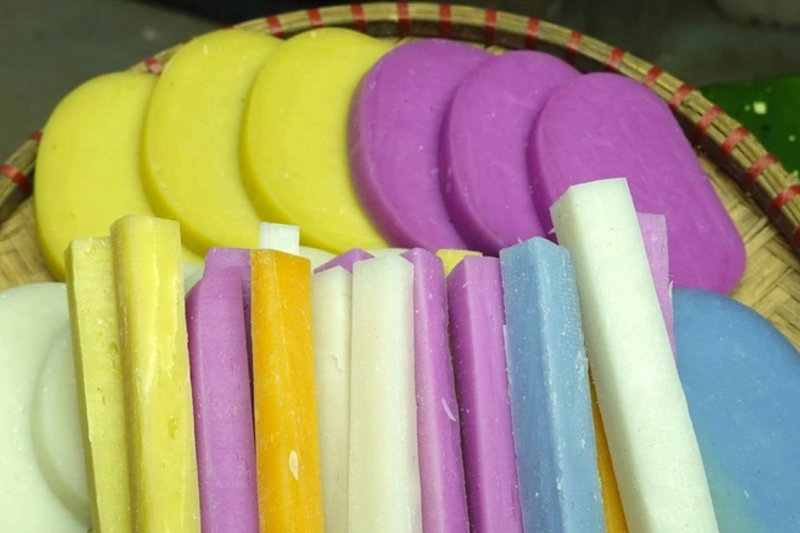
You Might Also Like
Ha Giang Weather in September: Complete Guide for Travelers
Exploring the magnificent Ha Giang Loop in September offers travelers a perfect balance of favorable[...]
Quan Ba Twin Mountains: Ha Giang’s Iconic Fairy Hills and Complete Travel Guide
The mystical Quan Ba Twin Mountains rise from the emerald valleys of Ha Giang like[...]
Vuong family mansion: the architectural marvel and cultural legacy of Ha Giang
Deep in Vietnam’s northern highlands, where mist-shrouded mountains meet terraced rice fields, stands a testament[...]
Ha Giang Loop Safety Tips: How to Ride Securely in Vietnam’s Northern Mountains
The Ha Giang Loop, with its winding mountain roads and breathtaking landscapes, offers one of[...]
The Ultimate Guide to the M-Shaped Curve on Ha Giang Loop
Vietnam’s remote northern province of Ha Giang hides a natural wonder that has captivated adventurous[...]
Most Beautiful Places to Visit in Vietnam: Essential Destinations and Insider Tips
Vietnam captivates travelers with its stunning landscapes, rich cultural heritage, and warm hospitality. From mist-shrouded[...]
Beyond the Beaten Path: Discovering Ha Giang Province in Northeast Vietnam
Ha Giang Province in Northeast Vietnam stands as one of the country’s last frontiers for[...]
Rainy season in Ha Giang: what to expect, when to go, and travel tips
Vietnam’s northern frontier reveals a different face during the rainy season, transforming Ha Giang’s limestone[...]